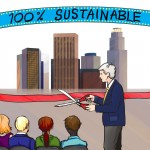Only a year since its launch, UCLA’s Grand Challenges initiative is already behind schedule.
Under the theme of “Thriving in a Hotter Los Angeles,” UCLA announced the plan in November 2013 in hopes of achieving 100 percent sustainability in Los Angeles by 2050. The plan consists of numerous projects that aim for improvements in three areas: water, energy use and biodiversity.
As a result of manpower constraints and program restructuring bound to happen in an initiative with such large and lofty goals, the organizers had to push the timeline of the Grand Challenges initiative.
The huge scale of the initiative makes it both a commendable program that we can look to for groundbreaking progress in sustainability, and also a time-consuming project likely to continue suffering from delays. As a community, we cannot rely on the Grand Challenges as our only outlet in the search for sustainable living.
UCLA students and staff should credit the program for its ambition and the breadth of its scope in achieving sustainable living in the city of Los Angeles. A program like the Grand Challenges has the potential to act as a model for other cities and universities across the nation and the world. But we should not view the announcement of the plan as an end-all solution, and continue taking smaller incremental steps to improve sustainability at the institution of UCLA and in our own lives.
Just last week, James Economou, the vice chancellor for research, announced the committee rosters for the plan. He said the committees would be responsible for ensuring that research plans for each area be completed by June 30, 2015, a year later than previously announced. This change would push back the completion date for research from 2019 to 2020. The number of projects under each area has also been reduced from the originally announced six to three or four.
UCLA has set the bar high with the Grand Challenges’ goals, and while that’s not inherently a bad thing, it is taking more planning and coordinating than expected. And the unexpected largeness of the project is causing a change of plans.
Richard Wirz, aerospace engineering associate professor and member of the Grand Challenges steering committee told the Daily Bruin that he was skeptical they could complete the project on time.
Besides the enormity of the goals is the tight timetable the team has laid out for itself. The aggressive schedule promises research plans will be finalized by June 30, 2015.
Given that the project is behind schedule, and members of the team have expressed doubts that future deadlines can be met, students and faculty members shouldn’t forget about other steps we can take as an institution and as individuals to increase sustainability. Students and faculty should set out smaller, incremental goals that focus on achieving change on campus, steps which are more likely to see success in the short term.
Although Los Angeles is yes, smaller than the world, it is still a large city, and thus a large undertaking. Students and faculty members should continue to focus their efforts on improving sustainability at UCLA, and the school is already showing promise with its numerous initiatives on climate and energy, landscaping and more.
UCLA, along with the University of California system, is working to achieve numerous sustainability goals in seven operational areas, as laid out in the UC Policy on Sustainable Practices. We should expand on these existing efforts, which include steps to reduce greenhouse emissions and achieve 20 percent reduction in water use by 2020. We should also continue making efforts to live sustainable lives individually.
To be clear, the large scale of the project is a good idea; we need to set the bar high to make large strides that benefit the lives of people in Los Angeles outside the UCLA bubble.
And even if the team doesn’t achieve 100 percent sustainability, that doesn’t constitute a failure; some improvement is still better than nothing.
But at the same time, the project intended to be a grand challenge for sustainability in Los Angeles is appearing to have become a grand challenge of logistics and organization for the university. In order to achieve its goal, UCLA needs to continue the project with feasibility in mind, while the rest of the UCLA community pursues tangible change on its own terms.
